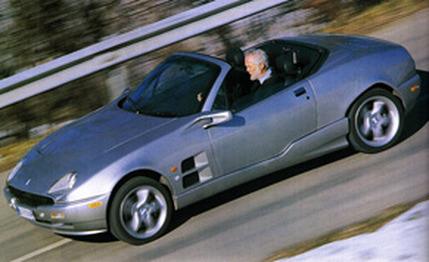 First Drive Review
First Drive Review
The supercar Mecca of the world is a small town in Italy called Modena, home to Maserati, Lamborghini, De Tomaso, and of course, Ferrari. Add to that list the very non-Italian name of Qvale.
Qvale Modena is a privately owned American company that has set up a 120,000-square-foot factory on the outskirts of town to assemble the $80,945 De Tomaso Mangusta.
Perhaps you remember the first Mangusta, Giorgetto Giugiaro's gorgeous 1969 coupe? Remember De Tomaso? It's been 26 years since Lincoln-Mercury dealers stopped selling the mid-engined, Ford-powered De Tomaso Pantera. That effort folded, but De Tomaso survived, building exotic sports cars, including the Pantera (until 1992), in numbers measured in dozens rather than hundreds, at a small Modena factory.
This new Mangusta, also powered by a Ford V-8, first turned up at the 1996 Geneva auto show. Called the Bigua, it was styled by Marcello Gandini (of Lamborghini Countach and Diablo fame) and engineered by former Formula 1 designer Enrique Scalabroni. But Alejandro de Tomaso, tied to a wheelchair since a stroke in 1993, didn't have the lire to get the car produced. Enter Kjell Qvale (pronounced "shell kah-vah-lee"), the pioneering San Francisco-based importer who introduced the MG TC to the West Coast in 1947.
Qvale's sons, Bruce and Jeff, were apparently looking for a little more excitement than you'll find selling Jaguars, Audis, Land Rovers, and VWs. Their father's 30-year relationship with Signore de Tomaso helped pave the way for a licensing agreement signed in March 1998 with the Argentine-born former racer. The deal gives Qvale Modena the rights to build, distribute, and sell the cars, except in Italy and Britain. Then, when de Tomaso's company conceded it couldn't build the Mangusta in the required numbers, Qvale Modena bought a factory in which to assemble the car. Today, a new U-shaped, 12-station assembly line is being slowly ramped up to meet Qvale's quality objectives; it hopes to turn out 900 cars in 2001. The first 15 Mangustas were sold to U.S. customers in late February through four dealer outlets in Beverly Hills, Miami, San Francisco, and Baltimore; 60 more cars have been sold here since then.
"The risk is all ours," says Bruce Qvale, pointing out that Ferrari and Maserati now come under Fiat's umbrella, whereas Lamborghini is wholly owned by Audi. "We thought, Let's strap it on and go for a ride."
The engine note is an instant giveaway that the powerplant is an American V-8. Armed with this knowledge, you go looking for further evidence to identify the donor car. Sure enough--despite a Connolly-leather-trimmed interior and a brushed aluminum finish for the console, instruments, switchgear, and door handles--even the simple switches for the heater and air conditioner come straight from a Ford Mustang. Indeed, the dash arrives as a complete module from Visteon, a Ford parts company.
Blending American muscle with Italian design is an old automotive concept. Ford contributes the thoroughly up-to-date all-alloy 4.6-liter DOHC V-8 from the Mustang. Since the resin-transfer-molded, plastic-bodied, boxed-steel chassis of the Mangusta weighs 234 fewer pounds than does the bigger Mustang, the 320-horsepower powerplant, with its 314 pound-feet of torque, delivers nearly supercar performance with the implicit promise of long-term durability from a mass-produced engine. Likewise, the Borg-Warner five-speed manual transmission.
There's no getting away from the car's American origins. The driveline, and its mellow sound, is pure Mustang. Given that this V-8 loves to rev--the redline is at 6800 rpm--any lack of the traditional low-end grunt expected from an American bent-eight is no impediment and positively enhances the Mangusta's sporting character. Qvale claims the car will go from 0 to 60 mph in 5.5 seconds. The Mangusta we drove felt at least that quick. Conversely, a long-winded gearchange, a touch of driveline slack, and wide ratios, culminating in a super-tall fifth (spinning out 33.4 mph per 1000 rpm), detract from its allure on Europe's more driver-oriented roads. A healthy power-to-weight ratio disguises the broad spread between the ratios, but the Mangusta would certainly benefit from more closely spaced gearing and maybe a sixth cog.